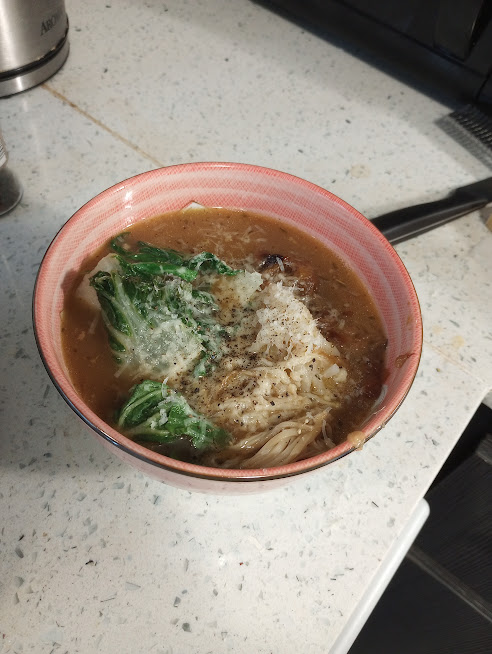I woke up abruptly one morning out of a forgotten dream, the words “French onion ramen” lingering on my lips. Sounded like a great idea, so I went for it!
My goal was to make not just “French onion soup with ramen noodles” but something that was more balanced between French and Japanese flavors.
Elements of French onion soup: browned beef bone broth, caramelized onions, toasted bread of some sort, melted cheese (generally browned).
Elements of tonkatsu ramen: long-simmered pork broth, tare (booze/sweet/salt/umami paste), noodles, pork belly, medium-boiled eggs, veggies.
Let us set aside the pork belly and the eggs. I cured the pork belly as in the recipe below (which I made last time), put it in the oven, and fucking forgot about it. It was charcoal by the time I remembered.
And I just completely forgot about the eggs.
Buh.
Broth:
- 6 pounds of meaty pork neck bones
- trimmings from a 5-pound bag of yellow onions, including skins
- various other veggies going bad in the fridge
Bake at 400F for about 45 minutes, then add to a stock pot, cover with cold water, boil at a rolling boil until the tendons are completely melted. This was about 12 hours total, with overnight refrigeration in the middle. I had to add water about every hour or so. I covered the pot. The broth ends up about the consistency of jello jigglers in the fridge, the kind that kids throw at the floor just to see it bounce.
I think the long boil time was worth it, not least of which because OMG THE SMELL is worth bottling and selling as a food-desiac.
I’m gonna go out on a limb and say I would NOT use beef bones instead, given the opportunity, and I WOULD roast the bones beforehand the next time I make tonkatsu ramen. Browned pork broth seems like the appropriate choice for both French onion and tonkatsu ramen. It smells like spirit of caramelization; plus, neck bones have a ton of tendon and made a great gelatin. Go for it.
Once the the tendons were melted, I strained out all the material, tossed it, and reheated the broth with some thyme and bay leaf. (I didn’t want the bay leaf to be too freaking strong.) Next time, I would salt the broth to a barely-noticeable level of saltiness. That tare was difficult to adjust all on its own.
Onions:
Caramelized the heck out of five pounds of onions. I wish I had doubled or tripled the amount. I did a very slow caramelization; I was already stuck in the kitchen for a while to babysit the broth. Onions halved, cut in thin rings, cooked over a medium-low heat with butter, salt, and a little brandy.
Tare:
- 1/4c shiro miso paste
- 1/2c or so brandy
Cook over low heat and stir until you have a smooth paste about like honey or a little thinner. I added another bit of brandy toward the end and didn’t cook it down enough; the raw alcohol taste was a bit much.
Noodles:
I got two packages of “Japanese noodles” from the Korean grocery store. They were a little gummy; I think I’ll look for another brand next time. Advice on this point would be welcome.
Veggies:
- 1 package Enoki mushrooms, bottom trimmed and trimmings used with broth.
- 8-10 baby bok choi, bottoms trimmed and tossed, washed.
- butter
- brandy
- salt
I sauteed the mushrooms in brandy and butter and salt, set them aside, then sauteed the (rinsed wet) bok choi with butter, with a lid over the pan. These both turned out great.
Cheese:
- Swiss gruyere from Aldi’s.
I don’t have good bowls to use under a broiler anymore, so I decided to cut up matchstick sized pieces of cheese to hide in the bowl, plus grated some on top.
Assemblage:
Two teaspoonfuls of tare at the bottom of the bowl or to taste; ladle in a scoop of broth and stir, adjust for flavor. Add noodles, then cheese matchsticks, then veggies. Add more broth to cover the noodles. Grate a bunch of cheese on top. Serve.
I also put taijin seasoning on the table, because that’s what I used last time instead of furikake (for Ray’s birthday). Is good. Can recommend.
I am still regretful about the pork belly turning to char. AIYYYY.
Here was the starting recipe: https://glebekitchen.com/tonkotsu-ramen-home/


